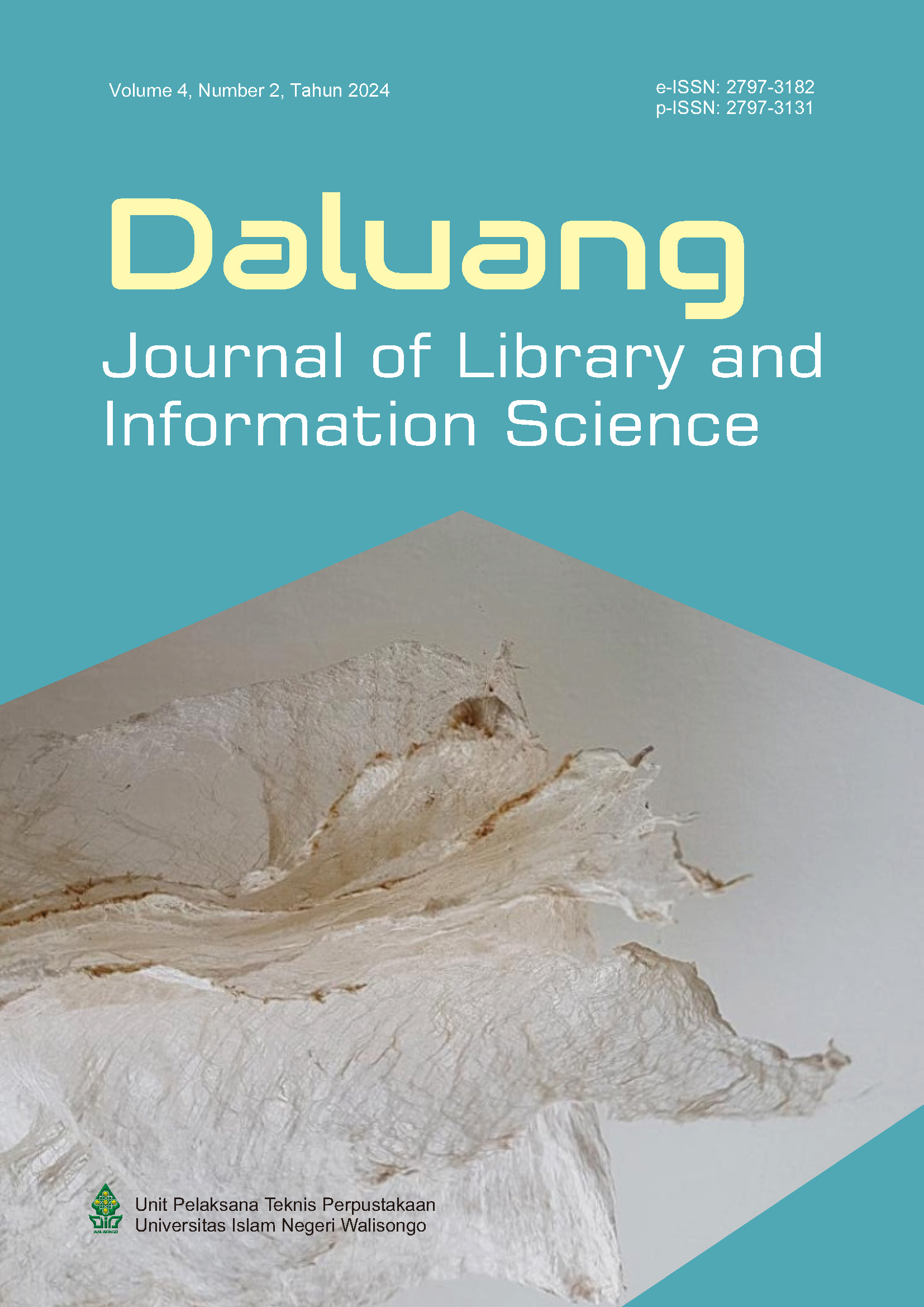Optimalisasi layanan teknologi digital berbasis Total Quality Management (TQM) di Dinas Kearsipan Dan Perpustakaan Provinsi Jawa Tengah
Main Article Content
Abstract
Purpose. This study aims to assess the optimization of iJateng services at the Dinas Kearsipan dan Perpustakaan Provinsi Jawa Tengah using Total Quality Management (TQM) principles. Additionally, it seeks to identify challenges and propose strategies for enhancing service performance and efficiency.
Methodology. Employing a qualitative descriptive approach, this research collects data through observation, interviews, and documentation to provide an in-depth analysis of the optimization process.
Results and discussion. Findings reveal that the optimization of iJateng services incorporates TQM elements, including 1) benchmarking, 2) continuous improvement, 3) staff empowerment, 4) teamwork, 5) user identification, 6) listening to users, 7) process analysis, and 8) statistical process control. Despite these efforts, challenges persist, such as a limited reading culture, budget constraints, and insufficient socialization efforts.
Conclusions. The optimization of digital library services through the iJateng application has been implemented effectively using TQM principles, demonstrating a commitment to continuous improvement. Libraries aiming to develop or enhance digital services can adopt TQM strategies to enhance service quality and user satisfaction. Addressing the identified obstacles, particularly in fostering a reading culture and improving outreach, will further enhance the impact and accessibility of digital library services.
Downloads
Article Details

This work is licensed under a Creative Commons Attribution-NonCommercial-NoDerivatives 4.0 International License.
This work is licensed under a Creative Commons Attribution-NonCommercial-NoDerivatives 4.0 International License.
Articles published in Daluang Journal of Library and information Science are available under Creative Commons Attribution Non-Commercial No Derivatives Licence (CC BY-NC-ND 4.0). Authors retain copyright in their work and grant Daluang Journal of Library and information Science right of first publication under CC BY-NC-ND 4.0. Users have the right to read, download, copy, distribute, print, search, or link to the full texts of articles in this journal, and to use them for any other lawful purpose.
Articles published in Daluang Journal of Library and information Science can be copied, communicated and shared in their published form for non-commercial purposes provided full attribution is given to the author and the journal. Authors are able to enter into separate, additional contractual arrangements for the non-exclusive distribution of the journal's published version of the work (e.g., post it to an institutional repository or publish it in a book), with an acknowledgment of its initial publication in this journal.
This copyright notice applies to articles published in Daluang Journal of Library and information Science volumes 1 onwards.
References
Anugrah, A., & Amrullah, A. M. K. (2022). Tipologi Manajemen Tradisional dan Modern dan Klasifikasinya dalam Manajemen Pendidikan Islam. The Teacher of Civilization: Islamic Education Journal, 3(1). https://journal.iain-manado.ac.id/index.php/jpai/article/view/1792
Bruce, C. S. (2013). Information literacy research and practice: an experiential perspective. Worldwide Commonalities and Challenges in Information Literacy Research and Practice: European Conference on Information Literacy, ECIL 2013 Istanbul, Turkey, October 22-25, 2013 Revised Selected Papers 1, 11–30. https://link.springer.com/chapter/10.1007/978-3-319-03919-0_2
Dahlgaard, J. J., Kanji, G. K., & Kristensen, K. (2008). Fundamentals of total quality management. Routledge. https://doi.org/10.4324/9780203930021
Elva, R. (2019). Manajemen perpustakaan: Penerapan TQM dan CRM. In Depok: Rajawali Pers, Depok. Raja Grafindo Persada.
Ganggi, R. I. P. (2019). Evaluasi desain user interface berdasarkan user experience pada iJateng. Jurnal Ilmu Perpustakaan, 8(4), 11–21. https://ejournal3.undip.ac.id/index.php/jip/article/download/26854/23694
Goetsch, D. L., & Davis, S. B. (2016). Quality management for organizational excellence: Introduction to total quality. Pearson.
Hartinah, S. (2009). Pemanfaatan alih media untuk pengembangan perpustakaan digital. Visi Pustaka, 11(3), 13–18.
Hartono. (2019). Manajemen perpustakaan elektronik (e-library): Konsep dasar, dinamika dan sustainable di era digital. Gava Media.
Kar, D. C., & Seadle, M. (2004). International Conference on Digital Libraries 2004 Conference. Library Hi Tech News, 21(5), 3–7. https://doi.org/10.1108/07419050410546301
Kotler, P., Keller, K., Ang, S., Tan, C., & Leong, S. (2017). Marketing Management : An Asian Perspective. Pearson.
Laudon, K. C., & Laudon, J. P. (2020). Management information systems: Managing the digital firm. Pearson.
Malaji, A. (2022). Perpustakaan digital. Dinas Perpustakaan dan Kearsipan Pangkal Pinang Kota. https://dispersip.pangkalpinangkota.go.id/perpustakaan-digital/
Mikesell, J. L. (2018). Fiscal administration : Analysis and applications for the public sector (10 ed.). Cengage Learning.
Morgan, C., & Murgatroyd, S. (1994). Total quality management in the public sector: An international perspective. McGraw-Hill Education (UK).
Noprianto, E. (2018). Tantangan dalam mewujudkan perpustakaan digital. Pustakaloka, 10(1), 104–112. https://doi.org/10.21154/pustakaloka.v10i1.1212
Osborne, S. P., & Brown, L. (2013). Handbook of innovation in public services. Edward Elgar Publishing.
Peraturan Kepala Dinas Kearsipan dan Perpustakaan Provinsi Jawa Tengah Nomor 487.22/5315 Tahun 2021 tentang Standar Pelayanan dan Maklumat Pelayanan Dinas Kearsipan dan Perpustakaan Provinsi Jawa Tengah, Pub. L. No. 487.22/5315 Tahun 2021 (2021). https://perpus.jatengprov.go.id/download/file/Standar_Pelayanan.pdf
Purwaningsih, & Dewi, A. O. P. (2019). Evaluasi kualitas layanan perpustakaan digital Ijateng menggunakan metode DigiQUAL. Jurnal ILmu Perpustakaan, 8(4), 214–227.
Rachman, R. (2017). Optimalisasi produksi di industri garment dengan menggunakan metode simpleks. Jurnal Informatika, 4(1). https://ejournal.bsi.ac.id/ejurnal/index.php/ji/article/view/1419
Rattu, P. N., Pioh, N. R., & Sampe, S. (2022). Optimalisasi kinerja bidang sosial budaya dan pemerintahan dalam perencanaan pembangunan (Studi di kantor badan perencanaan pembangunan, penelitian dan pengembangan daerah Kabupaten Minahasa). Governance, 2(1), 1–9. https://ejournal.unsrat.ac.id/index.php/governance/article/view/40264
Rifauddin, M. (2016). Pengelolaan arsip elektronik berbasis teknologi. Khizanah al-Hikmah: Jurnal Ilmu Perpustakaan, Informasi, dan Kearsipan, 4(2), 168–178. https://doi.org/10.24252/kah.v4i27
Sari, S. N., & Salma, N. (2024). Peran media sosial sebagai promosi pemanfaatan jasa informasi di Perpustakaan Universitas Islam Negeri Imam Bonjol Padang. Jurnal Pustaka Ilmiah, 10(2), 235–248. https://doi.org/10.20961/jpi.v10i2.87098
Setiawan. (2009). Pengadaan bahan pustaka. https://repository.um.ac.id/1460/
Sugiyono. (2019). Metode penelitian kuantitatif kualitatif dan R&D. Alfabeta.
Sugiyono. (2021). Memahami penelitian kualitatif (Cet III). Alfabeta.
Undang-undang (UU) Nomor 43 Tahun 2007 tentang Perpustakaan, (2007). https://peraturan.bpk.go.id/Details/39968/uu-no-43-tahun-2007
Warschauer, M. (2004). Technology and social inclusion: Rethinking the digital divide. MIT press.
Writer, N. (2017, Juli 18). iJATENG: Aplikasi perpustakaan digital sudah bisa diakses. Bisnis.com. https://semarang.bisnis.com/read/20170718/535/767965/ijateng-aplikasi-perpustakaan-digital-sudah-bisa-diakses
Wulandari, E. R., Rizal, E., & Lusiana, E. (2021). Pengaruh kualitas website Kandaga terhadap kepuasan pengguna Perpustakaan Pusat Universitas Padjadjaran. Jurnal Kajian Informasi & Perpustakaan, 9(1), 79. https://doi.org/10.24198/jkip.v9i1.29146
Zurkowski, P. G. (2013). Information literacy is dead… long live information literacy. Worldwide Commonalities and Challenges in Information Literacy Research and Practice: European Conference on Information Literacy, ECIL 2013 Istanbul, Turkey, October 22-25, 2013 Revised Selected Papers 1, 1–10. https://doi.org/10.1007/978-3-319-03919-0_1



